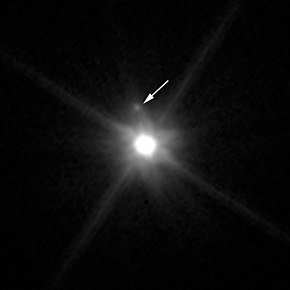This is an old revision of this page, as edited by Nrco0e (talk | contribs) at 04:41, 9 July 2024 (add CBET). The present address (URL) is a permanent link to this revision, which may differ significantly from the current revision.
Revision as of 04:41, 9 July 2024 by Nrco0e (talk | contribs) (add CBET)(diff) ← Previous revision | Latest revision (diff) | Newer revision → (diff) Moon of Makemake
 Makemake and its moon S/2015 (136472) 1 (arrow) Makemake and its moon S/2015 (136472) 1 (arrow) | |
| Discovery | |
|---|---|
| Discovered by |
|
| Discovery date | April 2015 |
| Designations | |
| Alternative names | MK2 (unofficial) |
| Orbital characteristics | |
| Semi-major axis | >21000 km |
| Eccentricity | unknown |
| Orbital period (sidereal) | >12.4 days |
| Satellite of | Makemake |
| Physical characteristics | |
| Mean radius | ~ 87.5 km (for an assumed albedo of 4%) |
| Albedo | 0.04 |
| Apparent magnitude | 25.0 |
| Absolute magnitude (H) | 7.8 |
S/2015 (136472) 1, unofficially nicknamed MK2 by the discovery team, is the only known moon of the trans-Neptunian dwarf planet Makemake. It is estimated to be 175 km (110 mi) in diameter (for an assumed albedo of 4%) and has a semi-major axis of at least 21,000 km (13,000 mi) from Makemake. Its orbital period is at least 12 days if it has a circular orbit. Observations leading to its discovery occurred in April 2015, using the Hubble Space Telescope's Wide Field Camera 3, and its discovery was announced on 26 April 2016.
Observations
A preliminary examination of the discovery imagery and Makemake's overall thermal emission suggests that MK2 has a reflectivity similar to charcoal, making it an extremely dark object. This is somewhat surprising because Makemake is the second-brightest-known object in the Kuiper belt. One hypothesis to explain this is that its gravity is not strong enough to prevent bright but volatile ices from being lost to space when it is heated by the distant Sun.
Alex Parker, the leader of the team that performed the analysis of the discovery images at the Southwest Research Institute, said that from the discovery images, MK2's orbit appears to be aligned edge-on to Earth-based observatories. This would make it difficult to detect because it would be lost in Makemake's glare much of the time, which, along with its dark surface, would contribute to previous surveys failing to observe it. Observations taken in 2018 and 2019 may be enough to determine whether the orbit is close to circular, which would suggest that MK2 was formed by an ancient impact event, or if it is significantly eccentric, which would suggest that it was captured.
Name
See also: Makemake (deity)As of 2024, the satellite has no official name. The designation S/2015 (136472) 1 is the satellite's provisional designation, with S/ indicating "satellite", 2015 being the satellite's year of discovery, and 1 being the satellite's order of discovery in that year. (136472) is Makemake's minor-planet number.
The nickname 'MK2' simply means object 2 in the Makemake system. A permanent name may be chosen from an associated figure in the mythology of Easter Island.
Notes
- Absolute magnitude difference between the satellite and Makemake
References
- ^ Parker, A. H.; Buie, M. W.; Grundy, W. M.; Noll, K. S. (25 April 2016). "Discovery of a Makemakean Moon". The Astrophysical Journal. 825 (1): L9. arXiv:1604.07461. Bibcode:2016ApJ...825L...9P. doi:10.3847/2041-8205/825/1/L9. S2CID 119270442.
- ^ "HubbleSite – NewsCenter – Hubble Discovers Moon Orbiting the Dwarf Planet Makemake (04/26/2016) – The Full Story". hubblesite.org. Retrieved 14 July 2022.
- ^ William M. Grundy (13 February 2020). "Makemake (136472 2005 FY9)". Lowell Observatory. Retrieved 20 February 2020.
- {{broken ref
|prefix=Cite error: The named reference
{
Unexpected use of template {{1}} - see Template:1 for details. (see the help page). - ^ Parker, A. (2 May 2016). "A Moon for Makemake". Planetary Society blogs. Planetary Society. Retrieved 2 May 2016.
- ^ Green, Daniel W. E. (26 April 2016). "S/2015 (136472) 1". Central Bureau Electronic Telegram (4275). Central Bureau for Astronomical Telegrams. Bibcode:2016CBET.4275....1P.
{{cite journal}}:|access-date=requires|url=(help) - ^ Mike Wall (26 April 2016). "Distant Dwarf Planet Makemake Has Its Own Moon". Space.com. Retrieved 26 April 2016.
- "JPL Small-Body Database Browser: 136472 Makemake (2005 FY9)". NASA Jet Propulsion Laboratory (2019-05-12 last obs). Archived from the original on 16 June 2019. Retrieved 20 February 2020.
- "Naming of Astronomical Objects". International Astronomical Union. Retrieved 8 July 2017.
- International Astronomical Union (19 July 2008). "Fourth dwarf planet named Makemake" (Press release). International Astronomical Union (News Release – IAU0806). Archived from the original on 23 July 2008. Retrieved 20 July 2008.
Cite error: A list-defined reference named "NYT-20160427" is not used in the content (see the help page).External links
- MPEC 2016-H46 : S/2015 (136472) 1, Minor Planet Center, 26 April 2016
Moons of likely dwarf planets Pluto Haumea Eris Makemake Gonggong
Quaoar Orcus Salacia Varda 2013 FY27
Natural satellites of the Solar System Planetary
satellites of



Dwarf planet
satellites of
Minor-planet
moons
Ranked
by size
